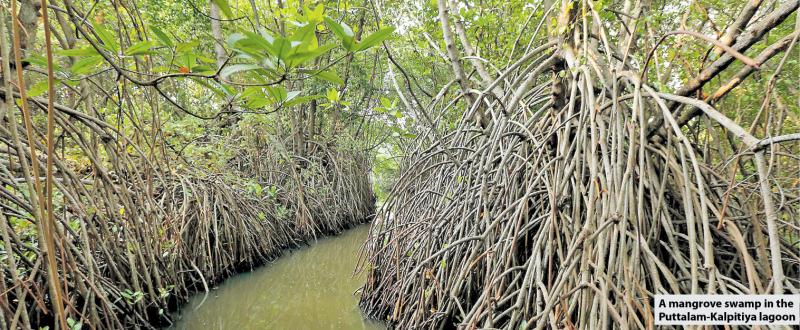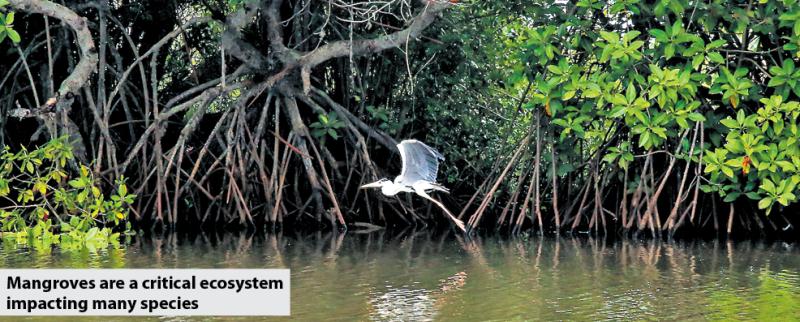As of late, Sri Lanka has been seeing an uptick in alleged illegal deforestation in many forest areas.
While names of several politicians have been entangled with the reported incidents, any direct involvement of these politicians is yet to be confirmed.
It is in this backdrop that several reports of destruction were reported from the Kalpitiya area where a larger area of mangroves has been cleared for prawn farming with the blessings of a local government politician.
The Sunday Morning learnt that in addition to the destruction caused to mangroves, allegedly for prawn farming, there are also allegations that several other areas have already been cleared and fake deeds have been given to several families within mangrove zones in the Puttalam-Kalpitiya lagoon, which are governed by the Forest Conservation Ordinance.
As alleged by environmentalists, the destruction had been caused to the mangroves situated adjacent to the Puttalam-Kalpitiya lagoon, where most of the mangroves are situated, as well as the estuaries of the Eastern Province.
A critical coastal ecosystem
Mangroves are small trees or shrubs that grow in brackish and saline water along tropical and subtropical shorelines. Their stilted roots are anchored in underwater sediment and extend above the surface.
Mangroves are a critical coastal ecosystem that impacts human lives as well as nourishes biodiversity as nursery grounds for many coastal and marine species and support fisheries. They buffer coastal communities against extreme weather events such as hurricanes, stabilise coastlines, and slow down or reduce soil erosion.
In the coastal area of the Puttalam District, mangroves play a vital role and are considered the most valuable coastal ecosystem that protects the coastal region. Also, mangroves provide a shield against the effects of climate change, such as coastal erosion and rising sea level. There are 16 genuine mangrove varieties and 12 other plants belonging to the mangrove community around the lagoon.
The Puttalam lagoon is the second largest lagoon in Sri Lanka and its environmental productivity is very high compared to the other lagoons.
Mangroves are important for the fish, crab, and shrimp farm industry. They provide accommodation, protection, and food for all kind of species; conserve corals; and nourish sea grass. Moreover, the extracted juice is used for colouring fishing nets to reduce decaying. The shrub is also used for constructing houses; for erecting fences and wood pillars; for herbs, food, and beverages; for the honey to attract bees; for tourism; and for providing protection from strong winds, tsunamis, and soil erosion.
Mangrove cover drastically reduced
Speaking to
The Sunday Morning, Environmental Conservation Trust (ECT) Director Sajeewa Chamikara alleged that there were several reports and incidents reported from the Puttalam-Kalpitiya area where severe destruction has been caused to mangroves.
However, as he explained, these mangroves are not declared as Ramsar wetlands but are governed under the Forest Conservation Ordinance.
“Only a few mangroves (areas) have been declared as Ramsar wetlands, and all others are governed under the Forest Department,” Chamikara said, adding that the recently cleared area in Kalpitiya was not a sanctuary, but it is prohibited to clear these wetlands.
“The land clearance has occurred not only for prawn farming, but also for human habitats. Deeds have been made for a few of these lands that have already been cleared and the environmental damage caused due to the clearance is yet to be evaluated,” he added.
As highlighted by environmentalists, the Forest Department should take immediate action to stop the destruction of these mangroves from any sort of human activity. Meanwhile, Centre for Environmental Justice (CEJ) Executive Director Hemantha Withanage stressed that the mangrove cover in Sri Lanka has been drastically reduced during the last decade.
In 2010, a survey showed that Sri Lanka has a 12,000 ha mangrove cover, but with the clearances reported since 2010, the environmentalists believe that the mangrove cover has now been reduced to around 8,000 ha.

Various acts of mangrove destructions have been reported since 2010, especially in the areas of Batticaloa, Mullaitivu, Kilinochchi, Wanathawilluwa, and Negombo, Withanage said, adding that mangrove re-growing projects would not solve the damage already caused to the environment.
According to the report of the Department of Coast Conservation and Coastal Resource Management in 1986, the total land occupied by mangroves was 12,189 ha. The recent activities had caused the decline of mangrove occurrence. In 2002, the total amount of mangrove-occupied land was 6,000 ha.
At present, there are 24 mangrove species of 12 families in Sri Lanka, and mangroves are mainly situated in the Districts of Jaffna, Kilinochchi, Mullaitivu, Trincomalee, Batticaloa, Ampara, Hambantota, Matara, Galle, Kalutara, Colombo, Gampaha, Puttalam, and Mannar.
Moreover, mangroves in Sri Lanka are composed of 20 species of true mangroves and 24 species of mangrove associates, which is one-third of all mangrove species in the world.
However, due to the destruction of mangroves, many environmental challenges have been triggered. As learnt by
The Sunday Morning, 74% of mangrove forests have been lost in Sri Lanka since the 19th Century.
Awaiting report
When contacted by
The Sunday Morning, Forest Department Deputy Forest Conservator – Protection and Law Enforcement H.W.K. Jayathilake said the Department was informed about the incident in Kalpitiya and a report has already been called in this regard.
“We are waiting for the report. We can comment on the incident and the area that has been affected only once we receive the report,” he stressed.
In the meantime, the Auditor General’s Department has also paid special attention to the destruction caused to the wetlands around the country, including mangroves.
Deputy Auditor General P.L.K Perera told
The Sunday Morning that the Department has instructed the Ministry of Wildlife and Forest Conservation and the Sri Lanka Land Reclamation and Development Corporation (SLLRCD) to take immediate action to protect all 227 wetlands identified by the Department around the country.
According to him, a report has been presented to Parliament at the end of last year, in which the Department has reiterated the importance of protecting all wetlands, especially the controversial Anawilundawa Wetland Sanctuary in Puttalam.
Meanwhile, all attempts made by
The Sunday Morning to contact Minister of Wildlife and Forest Conservation C.B. Rathnayake were futile.
 By Maheesha Mudugamuwa
By Maheesha Mudugamuwa Various acts of mangrove destructions have been reported since 2010, especially in the areas of Batticaloa, Mullaitivu, Kilinochchi, Wanathawilluwa, and Negombo, Withanage said, adding that mangrove re-growing projects would not solve the damage already caused to the environment.
According to the report of the Department of Coast Conservation and Coastal Resource Management in 1986, the total land occupied by mangroves was 12,189 ha. The recent activities had caused the decline of mangrove occurrence. In 2002, the total amount of mangrove-occupied land was 6,000 ha.
At present, there are 24 mangrove species of 12 families in Sri Lanka, and mangroves are mainly situated in the Districts of Jaffna, Kilinochchi, Mullaitivu, Trincomalee, Batticaloa, Ampara, Hambantota, Matara, Galle, Kalutara, Colombo, Gampaha, Puttalam, and Mannar.
Moreover, mangroves in Sri Lanka are composed of 20 species of true mangroves and 24 species of mangrove associates, which is one-third of all mangrove species in the world.
However, due to the destruction of mangroves, many environmental challenges have been triggered. As learnt by The Sunday Morning, 74% of mangrove forests have been lost in Sri Lanka since the 19th Century.
Awaiting report
When contacted by The Sunday Morning, Forest Department Deputy Forest Conservator – Protection and Law Enforcement H.W.K. Jayathilake said the Department was informed about the incident in Kalpitiya and a report has already been called in this regard.
“We are waiting for the report. We can comment on the incident and the area that has been affected only once we receive the report,” he stressed.
In the meantime, the Auditor General’s Department has also paid special attention to the destruction caused to the wetlands around the country, including mangroves.
Deputy Auditor General P.L.K Perera told The Sunday Morning that the Department has instructed the Ministry of Wildlife and Forest Conservation and the Sri Lanka Land Reclamation and Development Corporation (SLLRCD) to take immediate action to protect all 227 wetlands identified by the Department around the country.
According to him, a report has been presented to Parliament at the end of last year, in which the Department has reiterated the importance of protecting all wetlands, especially the controversial Anawilundawa Wetland Sanctuary in Puttalam.
Meanwhile, all attempts made by The Sunday Morning to contact Minister of Wildlife and Forest Conservation C.B. Rathnayake were futile.
Various acts of mangrove destructions have been reported since 2010, especially in the areas of Batticaloa, Mullaitivu, Kilinochchi, Wanathawilluwa, and Negombo, Withanage said, adding that mangrove re-growing projects would not solve the damage already caused to the environment.
According to the report of the Department of Coast Conservation and Coastal Resource Management in 1986, the total land occupied by mangroves was 12,189 ha. The recent activities had caused the decline of mangrove occurrence. In 2002, the total amount of mangrove-occupied land was 6,000 ha.
At present, there are 24 mangrove species of 12 families in Sri Lanka, and mangroves are mainly situated in the Districts of Jaffna, Kilinochchi, Mullaitivu, Trincomalee, Batticaloa, Ampara, Hambantota, Matara, Galle, Kalutara, Colombo, Gampaha, Puttalam, and Mannar.
Moreover, mangroves in Sri Lanka are composed of 20 species of true mangroves and 24 species of mangrove associates, which is one-third of all mangrove species in the world.
However, due to the destruction of mangroves, many environmental challenges have been triggered. As learnt by The Sunday Morning, 74% of mangrove forests have been lost in Sri Lanka since the 19th Century.
Awaiting report
When contacted by The Sunday Morning, Forest Department Deputy Forest Conservator – Protection and Law Enforcement H.W.K. Jayathilake said the Department was informed about the incident in Kalpitiya and a report has already been called in this regard.
“We are waiting for the report. We can comment on the incident and the area that has been affected only once we receive the report,” he stressed.
In the meantime, the Auditor General’s Department has also paid special attention to the destruction caused to the wetlands around the country, including mangroves.
Deputy Auditor General P.L.K Perera told The Sunday Morning that the Department has instructed the Ministry of Wildlife and Forest Conservation and the Sri Lanka Land Reclamation and Development Corporation (SLLRCD) to take immediate action to protect all 227 wetlands identified by the Department around the country.
According to him, a report has been presented to Parliament at the end of last year, in which the Department has reiterated the importance of protecting all wetlands, especially the controversial Anawilundawa Wetland Sanctuary in Puttalam.
Meanwhile, all attempts made by The Sunday Morning to contact Minister of Wildlife and Forest Conservation C.B. Rathnayake were futile.
